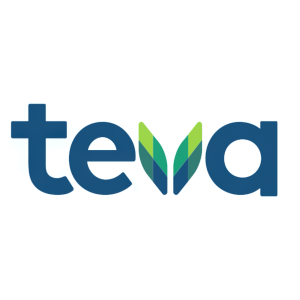Teva to Present New Long-Term AUSTEDO® (deutetrabenazine) Tablets Data at American Psychiatric Association Annual Meeting
Teva Pharmaceuticals, a U.S. affiliate of Teva Pharmaceutical Industries Ltd. (NYSE and TASE: TEVA), today announced new data from the 3-year open-label extension study of AUSTEDO® (deutetrabenazine) Tablets that studied patients with tardive dyskinesia (TD) will be presented at the 2021 American Psychiatric Association (APA) Virtual Annual Meeting, being held online from May 1-3.
The new data includes three abstracts that examine the long-term safety, quality of life (QoL) and patient-centered outcome measures of patients living with TD who were treated with AUSTEDO up to 145 weeks following two pivotal 12-week studies (ARM-TD and AIM-TD).
“TD is a serious movement disorder and we continue to evaluate AUSTEDO to determine its therapeutic potential following the pivotal clinical trials,” said Denisa Hurtukova, MD, VP, Head of North America Medical Affairs. “The data being presented at APA give healthcare providers valuable insights into safety and certain aspects of quality of life among TD patients, which could have an important impact on treatment considerations and ultimately the wellbeing of patients.”
In an analysis of the long-term safety of AUSTEDO, 337 patients with 723 patient-years of exposure were evaluated, all of whom had completed ARM-TD or AIM-TD. AUSTEDO was administered using a response-driven dosing regimen, titrating up to a maximum total daily dose of 48 mg/day based on dyskinesia control and tolerability. Safety measures included incidence of any adverse events (AEs), serious adverse events (SAEs) and AEs leading to withdrawal, dose reduction or dose suspension, as well as the most common AEs (≥4 percent). Since differences in incidence rates may be related to different durations of observation, exposure-adjusted incidence rates (EAIRs) were used to calculate AE frequencies. 269 (79.8 percent) patients reported ≥1 AE and AEs considered by the investigator to be treatment related were reported in 154 (45.7 percent) patients. Low EAIRs were reported for most AEs, including 1.22 for any AE, 0.09 for SAEs, 0.34 for treatment-related AEs, 0.06 for AEs leading to withdrawal, 0.05 for AEs leading to dose suspension, and 0.09 for AEs leading to dose reduction. The most common AEs (EAIRs) were anxiety (0.06), depression (0.05), somnolence (0.05), weight decreased (0.05) and urinary tract infection (0.05).
- Poster 4807: Long-Term Safety of Deutetrabenazine in Patients with Tardive Dyskinesia: Results from the Completed, 3-year Open-Label Extension Study
The OLE also investigated AUSTEDO in relation to patients’ QoL using the Modified Craniocervical Dystonia Questionnaire (mCDQ-24) score, a disease-specific QoL questionnaire adjusted to focus on the impact of TD. Patients’ QoL was evaluated based on the mean change +/- SE from baseline in the mCDQ-24 total score and the stigma, pain, activities of daily living (ADL), emotional and social subdomain scores through week 106. Of the 337 analyzed, changes in mean mCDQ-24 total scores from baseline were observed at week 6 (-3.2 +/- 0.68) and sustained through week 106 (-5.2 +/- 1.11). Treatment resulted in clinically meaningful improvements based on changes as measured by the mCDQ-24 total score and the stigma, pain, ADL, emotional and social subdomain scores.
- Poster 4849: Long-Term Deutetrabenazine Treatment is Associated with Sustained Improvements in Quality of Life in Patients with Tardive Dyskinesia
Finally, the OLE also evaluated patient-centric outcomes, including the percentage of patients to achieve treatment success (defined as “much improved” or “very improved”) on the Patient Global Impression of Change (PGIC), change from baseline in the patient-reported modified mCDQ-24 score and changes from baseline in the Abnormal Involuntary Movement Scale (AIMS) items 8, 9, 10, which are clinician-rated global judgments of the overall severity of abnormal movements, the incapacitation due to abnormal movements, and the patient’s awareness of abnormal movements, respectively. The analysis found more than half of the patients achieved PGIC treatment success at week 6, and the proportion increased over time from 54 percent at weeks 6 and 15, to 61 percent at week 54, 64 percent at week 106 and 63 percent at week 145. According to the mCDQ-24 score, patients demonstrated improvement in QoL at week 6 (mean change +/- SE from baseline: -3.2 +/- 0.68) that continued throughout the study (week 15, -5.0 +/- 0.70; week 54, -5.0 +/- 0.89; week 106, -5.2 +/- 1.11). Patients also experienced improvements from baseline in AIMS items 8, 9 and 10, which were sustained through week 145 (mean change +/- SE: -1.3 +/- 0.07 for item 8; -1.3 +/- 0.08 for item 9, and -1.3 +/- 0.09 for item 10).
- Poster 4390: Improvements in Patient-Centered Outcome Measures with Long-Term Deutetrabenazine Treatment Among Patients with Tardive Dyskinesia
Posters are available online and can be accessed via the APA meeting website at: www.psychiatry.org/annualmeeting.
AUSTEDO® Indications and Usage
AUSTEDO® is indicated for the treatment of chorea associated with Huntington’s disease and for the treatment of tardive dyskinesia in adults.
Important Safety Information About AUSTEDO®
Depression and Suicidality in Patients with Huntington’s Disease: AUSTEDO® can increase the risk of depression and suicidal thoughts and behavior (suicidality) in patients with Huntington’s disease. Balance the risks of depression and suicidality with the clinical need for treatmen








